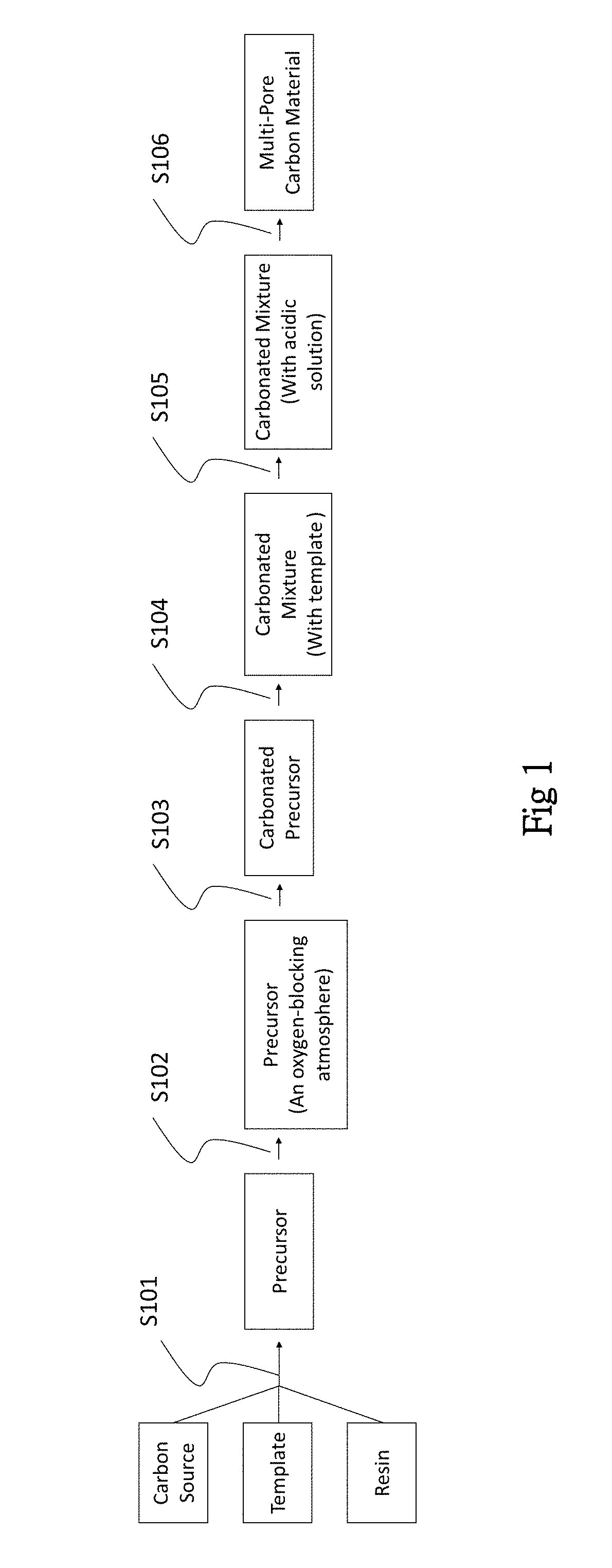Method for making multiporous carbon materials by using bio-oils
a technology of biooil and carbon materials, applied in the direction of inorganic chemistry, carbon compounds, chemistry apparatus and processes, etc., can solve the problems of more complicated processes in the prior art, and achieve the effects of reducing costs, simplifying production methods, and high cos
- Summary
- Abstract
- Description
- Claims
- Application Information
AI Technical Summary
Benefits of technology
Problems solved by technology
Method used
Image
Examples
example 1
[0038]As shown in FIG. 2, FIG. 3 and Table 1, the characteristic curve shows the multiporous carbon material measured at an average value and maximum value (precursor-ZnO:bio-oil=4:1) in the example 1 of the present invention and the multiporous carbon material. The process of making the multiporous carbon material by using the bio-oil is shown in FIG. 1, The precursor is prepared at a 4:1 weight ratio of ZnO and bio-oil. From the above measurement data, the multiporous carbon material has high surface area, which is mainly contributed by the surface area of the micropores and mesopores.
TABLE 1Surface areamicroporesmesoporesyieldratio(m2 / g)(m2 / g)(m2 / g)(%)4 / 11505337116713.2
example 2
[0039]As shown in FIG. 4, FIG. 5 and Table 2, the transmission electron microscopic images show the multiporous carbon material measured at an average value and maximum value (precursor-ZnO:carbon powder=6:1) in the example 2 of the present invention and the multiporous carbon material. The process of making the multiporous carbon material by using the bio-oil is shown in FIG. 1, The precursor is prepared at a 6:1 weight ratio of ZnO and carbon powder. From the above measurement data, the multiporous carbon material has high surface area, which is mainly contributed by the surface area of the micropores and mesopores.
TABLE 2Surface areamicroporesmesoporesyieldratio(m2 / g)(m2 / g)(m2 / g)(%)6 / 1112766146630.2
example 3
[0040]As shown in FIG. 6 and Table 3, the characteristic curve shows the multiporous carbon material measured at an average value and maximum value (precursor-ZnO:bio-oil:carbon powder=22:4:1) in the example 1 of the present invention and the multiporous carbon material. The process of making the multiporous carbon material by using the bio-oil is shown in FIG. 1, The precursor is prepared at a 22:4:1 weight ratio of ZnO, bio-oil and carbon powder. From the above measurement data, the multiporous carbon material has high surface area, which is mainly contributed by the surface area of the micropores and mesopores.
TABLE 3Surface areamicroporesmesoporesyieldratio(m2 / g)(m2 / g)(m2 / g)(%)22 / 4 / 1145463681813.7
PUM
 Login to View More
Login to View More Abstract
Description
Claims
Application Information
 Login to View More
Login to View More - R&D
- Intellectual Property
- Life Sciences
- Materials
- Tech Scout
- Unparalleled Data Quality
- Higher Quality Content
- 60% Fewer Hallucinations
Browse by: Latest US Patents, China's latest patents, Technical Efficacy Thesaurus, Application Domain, Technology Topic, Popular Technical Reports.
© 2025 PatSnap. All rights reserved.Legal|Privacy policy|Modern Slavery Act Transparency Statement|Sitemap|About US| Contact US: help@patsnap.com



